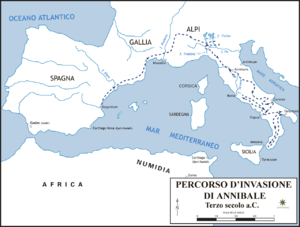Second battle of Capua
Coordinates: 41 ° 5 ′ 0 ″ N , 14 ° 15 ′ 0 ″ E
| date | 211 BC Chr. |
|---|---|
| place | Capua, Italy (now Santa Maria Capua Vetere ) |
| output | decisive Roman victory |
| Parties to the conflict | |
|---|---|
| Commander | |
| Troop strength | |
| a smaller army in the enclosed city, while the main army with Hannibal encamped in front of the city | unknown |
| losses | |
|
unknown |
low |
Saguntum - Lilybaeum II - Rhone - Ticinus - Trebia - Cissa - Lake Trasimeno - Ager Falernus - Geronium - Cannae - Nola I - Nola II - Ibera - Cornus - Nola III - Beneventum I - Syracuse - Tarentum I - Capua I - Beneventum II - Silarus - Herdonia I - Upper Baetis - Capua II - Herdonia II - Numistro - Asculum - Tarentum II - New Carthage - Baecula - Grumentum - Metaurus - Ilipa - Crotona - Large fields - Cirta - Zama
The Second Battle of Capua was a skirmish between the Romans and Carthaginians over the city of Capua in 211 BC. BC The Romans regained Capua.
prehistory
Quintus Flaccus and Appius Claudius Pulcher besieged as early as 212 BC. After the battle of Cannae the city of Capua came into the hands of the Carthaginians. Hannibal himself was out of town with a large part of his army. The Romans outnumbered the garrison of Capua; Hannibal had too few troops to attack the Roman legion camps surrounded by field fortifications. He therefore planned a mock attack on Rome itself. The background was presumably the hope that the Senate would then call back the Roman army to defend the metropolis. The retreating army should then be massively attacked. In March 211 BC Hannibal moved to Rome with a troop of Numidian horsemen, but found the metropolis so strongly fortified that he abandoned his plan and withdrew to Capua. The Romans had already made preparations to attack and began to attack when Hannibal's forces arrived. So the battle came about.
The battle
Hannibal had little prospect of being able to overrun the Roman overwhelming power in such an unfavorable situation. With the Roman camps located between the stone wall and wooden buildings, the superior Carthaginian cavalry could not be used effectively. The trapped Carthaginian forces resisted violently , but could not withstand the Roman siege technique , like battering rams , long enough. Hannibal's relief army did not appear until the Romans had already occupied the ramparts and received the Carthaginians with a hail of spears. Hannibal withdrew, the battle was decided in favor of the Romans.
consequences
Hannibal marched south and made no further attempts to retake the city of Capua. The two victorious consuls had the willingness of the people living in Capua to support Hannibal severely punished: They expropriated wealthy citizens and sent many into slavery . In doing so, they not only punished the “wrongdoers”, but also financed the campaign with the expropriations. This battle was viewed by ancient historians as the peripetia (turnaround) of the Second Punic War. A central element of the war strategy Hannibal, the solution of the Italian cities of Rome had failed because he obviously could not protect these cities from Rome. (Formally the most important Italian cities at that time were not subjects of a Roman empire, but allies of the city republic of Rome) From then on, Hannibal found himself on the strategic defensive.
See also
literature
- Gerhard Radke: Capua. In: The Little Pauly (KlP). Volume 1, Stuttgart 1964, Sp. 1048-1049.
- Roman History, Volume 2 by Wilhelm Ihne , Engelmann Verlag, 1896
